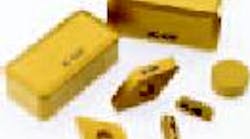Greenleaf's WG-600 ceramic-composite cutting tool reportedly cuts high-strength alloys at rates up to 6 faster than other ceramic inserts.
Greenleaf Corp., Saegertown, Pa., recently introduced a new aluminumoxide-coated, whisker-reinforced-ceramic insert that reportedly lasts up to 6 longer than other ceramic grades. Called WG-600, the inserts are made for high-temp alloys, but Greenleaf says they have potential for other applications, such as steels and ductile irons.
The inserts have successfully tackled real-world applications. One shop cutting 4-ft-diameter steel rolls measuring up to 6-ft long could not interrupt the cut because doing so would leave a line in the part surfaces. This line created a stress point during heat treating. But the cutters the shop was using didn't always make it through the whole cut.
Using a WG-600 insert, the shop cuts the full length of a roll — in nearly a 3-hr in-cut time — without problems or work stoppages. The insert also had plenty of life left after the cut.
To make the WG-600 reliable, Greenleaf says it had to have complete control over its coating process. That's because getting the coating to adhere to a ceramic substrate is more difficult than coating a carbide substrate, according to the company.
The tooling firm is also working on other advanced coated-ceramic grades. While most toolmakers add titanium nitride or some other carbide to the ceramic for notch resistance, Greenleaf found that another material works even better. "Ceramic materials have some porosity surface defects," says Choll Jun, vice president of technology, "and coatings cover them." Basically, coatings eliminate the places were chips initially start.
For thermal stability, Greenleaf conducted in-house testing between coated and uncoated ceramic tools. The company found the coated tools created less friction. In the same test cut, uncoated ceramic tools produced red-hot chips while coated tools made cool, dark ones.


